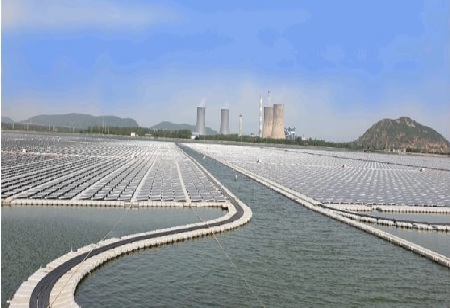NTPC announced that its 100 megawatt (MW) floating solar photovoltaic plant in Telangana is now fully operational.
In a BSE filing it said, "Consequent upon successful commissioning, last part capacity of 20 MW out of 100 MW Ramagundam floating solar PV project at Ramagundam, Telangana is declared on commercial operation with effect from 00:00 hours of 01.07.2022.
The project's reservoir spans 500 acres and was built with a cost of Rs. 423 crores through M/s BHEL's EPC (Engineering, Procurement and Construction) contract. 40 blocks, each with a 2.5 MW capacity. One floating platform and an array of 11,200 solar modules make up each block.
One inverter, a transformer, and a high-temperature breakers make up the floating platform.
The high density polyethylene (HDPE) floaters on which the solar panels are mounted.Through an unique HMPE (High Modulus Polyethylene) rope, the complete floating system is fastened to the dead weights positioned in the balancing reservoir bed. 33KV subterranean cables are used to evacuate the power up to the current switch yard.
The most evident virtue from an environmental standpoint is the minimal amount of land needed, largely for accompanying evacuation plans. Additionally, the presence of floating solar panels reduces the rate of water evaporation from water bodies, aiding in water conservation.
Shri Anand stated that NTPC had previously proclaimed the commercial operation of two floating solar projects: 92 MW at Kayamkulam (Kerala) and 25 MW at Simhadri (Andhra Pradesh). Ramagundam's 100-MW Floating Solar Project is equipped with cutting-edge technology and eco-friendly features.
The evaporation of about 32.5 lakh cubic metres of water annually can be stopped. The presence of a body of water beneath the solar panels keeps the temperature there stable, increasing production and efficiency.
Similarly, it is possible to reduce annual CO2 emissions by 2,10,000 metric tonnes while still avoiding annual coal usage of 1,65,000 metric tonnes.
